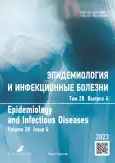Особенности профиля лекарственной устойчивости к противотуберкулёзным препаратам первого и второго ряда у пациентов с ВИЧ-инфекцией
- Авторы: Булычева Е.В.1, Булычев В.В.2, Величко Е.Н.1, Пашкова Н.А.2
-
Учреждения:
- Оренбургский государственный медицинский университет
- Оренбургский областной клинический противотуберкулёзный диспансер
- Выпуск: Том 28, № 4 (2023)
- Страницы: 218-229
- Раздел: ОРИГИНАЛЬНЫЕ ИССЛЕДОВАНИЯ
- URL: https://bakhtiniada.ru/1560-9529/article/view/131688
- DOI: https://doi.org/10.17816/EID448391
- ID: 131688
Цитировать
Аннотация
Обоснование. Профиль лекарственной устойчивости к противотуберкулёзным препаратам у пациентов непосредственно влияет на особенности протекания заболевания. Однако высокий процент у пациентов с ВИЧ-инфекцией множественной лекарственной устойчивости не только ухудшает течение заболевания, но и вынуждает разрабатывать новые тактики ведения таких пациентов.
Цель исследования — дать характеристику профиля лекарственной устойчивости на противотуберкулёзные препараты у пациентов с ВИЧ-инфекцией.
Материалы и методы. Исследование проведено на базе Оренбургского областного клинического противотуберкулёзного диспансера среди пациентов с впервые выявленным туберкулёзом молекулярно-генетическими и бактериальными методами исследования.
Результаты. Показано, что за период 2018–2022 годов возросла доля ВИЧ-инфицированных лиц, устойчивых на 14,6% к изониазиду и на 28,85% к рифампицину, на 717,39% к моксифлоксацину и на 104,25% к амикацину. Сокращение выбора лекарственных препаратов и возможности проведения эффективной противотуберкулёзной терапии у ВИЧ-инфицированных также осложняется выявлением у 20,34% обследованных полирезистентной культуры и у 39,6% пациентов — множественной лекарственной устойчивости. Кроме того, за пятилетний период увеличился процент мутаций в генах микобактерий, отвечающих за резистентность к противотуберкулёзным препаратам.
Заключение. Полученные данные определяют необходимость поиска новых решений в профилактике формирования резистентности к уже имеющимся противотуберкулёзным препаратам, разработки новых лекарственных эффективных средств для использования в качестве препаратов первого и второго ряда.
Ключевые слова
Полный текст
Открыть статью на сайте журналаОб авторах
Екатерина Владимировна Булычева
Оренбургский государственный медицинский университет
Автор, ответственный за переписку.
Email: e-sosnina@mail.ru
ORCID iD: 0000-0002-8215-8674
SPIN-код: 8985-3210
к.м.н.
Россия, ОренбургВячеслав Владимирович Булычев
Оренбургский областной клинический противотуберкулёзный диспансер
Email: vbolychev@yandex.ru
ORCID iD: 0000-0001-5963-4380
Россия, Оренбург
Елена Николаевна Величко
Оренбургский государственный медицинский университет
Email: lena.velichko.2012@mail.ru
ORCID iD: 0009-0005-5419-9574
Россия, Оренбург
Наталья Анатольевна Пашкова
Оренбургский областной клинический противотуберкулёзный диспансер
Email: pashkova.dom@mail.ru
ORCID iD: 0000-0002-1735-357X
Россия, Оренбург
Список литературы
- Gopalan N., Chandrasekaran P., Swaminathan S., Tripathy S. Current trends and intricacies in the management of HIV-associated pulmonary tuberculosis // AIDS Research and Therapy. 2016. Vol. 13, N 1. doi: 10.1186/s12981-016-0118-7
- World Health Organization. Global tuberculosis report 2015. 20th ed. 2015. Режим доступа: https://apps.who.int/iris/bitstream/handle/10665/191102/9789241565059_eng.pdf?sequence=1&isAllowed=y.
- Narendran G., Swaminathan S. TB-HIV co-infection: a catastrophic comradeship // Oral Dis. 2016. Vol. 22, Suppl 1. P. 46–52. doi: 10.1111/odi.12389
- Bonin C.R., Fochat R.C., Leite I.C.G., et al. Analysis of anti-tuberculosis drug resistance and sociodemographic and clinical aspects of patients admitted in a referral hospital // Einstein (Sao Paulo). 2019. Vol. 18. doi: 10.31744/einstein_journal/2020AO4620
- Игнатьева О.А. Лекарственная устойчивость штаммов Mycobacterium tuberculosis и оптимизация диагностических алгоритмов на примере Самарской области : дис. ... канд. биол. наук. Самара, 2015.
- Жданова С.Н., Огарков О.Б., Лац А.А., и др. Характеристика мутаций, ответственных за резистентность к противотуберкулёзным препаратам первого и второго ряда у штаммов Мycobacterium tuberculosis циркулирующих на территории Иркутской области и Республики Саха (Якутия) // Сибирский медицинский журнал. 2012. Т. 113, № 6. С. 64–67.
- Савинова А.А., Усанина Л.В. Механизмы антибиотикоустойчивости микобактерий туберкулёза // Международный студенческий научный вестник. 2017. № 6. Режим доступа: https://eduherald.ru/ru/article/view?id=17955.
- Kaplan J.E., Benson C., Holmes K.H., et al. Guidelines for prevention and treatment of opportunistic infections in HIV-infected adults and adolescents: recommendations from CDC, the National Institutes of Health, and the HIV Medicine Association of the Infectious Diseases Society of America // MMWR Recomm Rep. 2009. № 58 (RR-4). P. 1–207.
- Theron G., Peter J., Richardson M., et al. The diagnostic accuracy of the GenoType(®) MTBDRsl assay for the detection of resistance to second-line anti-tuberculosis drugs // Cochrane Database of Systematic Reviews. 2014. № 10. doi: 10.1002/14651858.CD010705.pub2
- Akolo C., Adetifa I., Shepperd S., Volmink J. Treatment of latent tuberculosis infection in HIV infected persons // Cochrane Database Syst Rev. 2010. N 1. doi: 10.1002/14651858.CD000171.pub3
- Mitchison D.A. Role of individual drugs in the chemotherapy of tuberculosis // Int J Tuberc Lung Dis. 2000. Vol. 4, N 9. P. 796–806.
- Recommendations for use of an isoniazid-rifapentine regimen with direct observation to treat latent Mycobacterium tuberculosis infection // Morb Mortal Wkly Rep. 2011. Vol. 60, N 48. P. 1650–1653.
- Sterling T.R., Villarino M.E., Borisov A.S., et al. Three months of weekly rifapentine and isoniazid for latent tuberculosis infection // N Engl J Med. 2011. Vol. 365, N 23. P. 2155–2166. doi: 10.1056/NEJMoa1104875
- Balcells M.E., Thomas S.L., Godfrey-Faussett P., Grant A.D. Isoniazid preventive therapy and risk for resistant tuberculosis // Emerg Infect Dis. 2006. Vol. 12, N 5. P. 744–751. doi: 10.3201/eid1205.050681
- Булычева Е.В., Булычев В.В., Пашкова Н.А. Проблема формирования новых рисков лекарственной устойчивости у больных туберкулёзом в условиях активного использования антибиотиков населением при COVID-19 // Проблемы социальной гигиены, здравоохранения и истории медицины. 2023. Т. 31, № 2. С. 157–163. doi: 10.32687/0869-866X-2023-31-2-157-163
- Булычев В.В., Пашкова Н.А., Булычева Е.В. Проблема неконтролируемого использования населением антибактериальных препаратов в формировании лекарственной устойчивости микобактерий в период пандемии COVID-19 // Фармацевтическое образование СамГМУ. История, современность, перспективы. Самара : Самарский государственный медицинский университет, 2021. С. 173–178.
- World Health Organization. Guidelines for intensified tuberculosis case-finding and isoniazid preventive therapy for people living with HIV in resource-constrained settings. Geneva: World Health Organization; 2011. Available at: https://apps.who.int/iris/handle/10665/44472.
Дополнительные файлы












